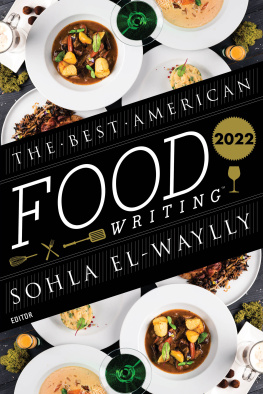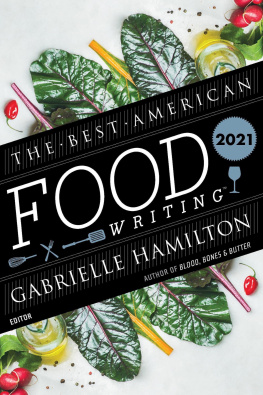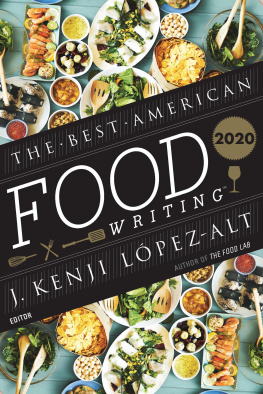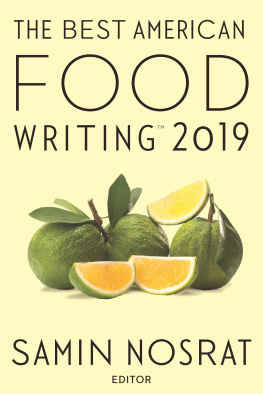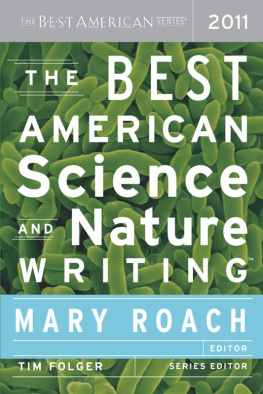Sohla El-Waylly - The Best American Food Writing 2022
Here you can read online Sohla El-Waylly - The Best American Food Writing 2022 full text of the book (entire story) in english for free. Download pdf and epub, get meaning, cover and reviews about this ebook. year: 2022, publisher: HarperCollins, genre: Children. Description of the work, (preface) as well as reviews are available. Best literature library LitArk.com created for fans of good reading and offers a wide selection of genres:
Romance novel
Science fiction
Adventure
Detective
Science
History
Home and family
Prose
Art
Politics
Computer
Non-fiction
Religion
Business
Children
Humor
Choose a favorite category and find really read worthwhile books. Enjoy immersion in the world of imagination, feel the emotions of the characters or learn something new for yourself, make an fascinating discovery.
- Book:The Best American Food Writing 2022
- Author:
- Publisher:HarperCollins
- Genre:
- Year:2022
- Rating:5 / 5
- Favourites:Add to favourites
- Your mark:
- 100
- 1
- 2
- 3
- 4
- 5
The Best American Food Writing 2022: summary, description and annotation
We offer to read an annotation, description, summary or preface (depends on what the author of the book "The Best American Food Writing 2022" wrote himself). If you haven't found the necessary information about the book — write in the comments, we will try to find it.
A collection of the years top food writing, selected by guest editor Sohla El-Waylly and series editor Silvia Killingsworth.
Culinary creator, writer and community advocate, Sohla El-Waylly selects the best twenty articles published in 2021 that celebrate the many innovative, comforting, mouthwatering, and culturally rich culinary offerings of our country.
The Best American Food Writing 2022 — read online for free the complete book (whole text) full work
Below is the text of the book, divided by pages. System saving the place of the last page read, allows you to conveniently read the book "The Best American Food Writing 2022" online for free, without having to search again every time where you left off. Put a bookmark, and you can go to the page where you finished reading at any time.
Font size:
Interval:
Bookmark:
ONE OF THE most paradoxical things about food is the sheer infinitude of effort that can be expendedor not!on it, with marginal effect on its intrinsic value. Some foods are celebrated for the amount of effort they require, whether in preparation (souffl) or harvest (coconut), while others are praised for their convenience or efficiency (instant rice, Soylent). Though we rightly cheer the things that are easywhat a relief to have dinner ready in under thirty minutes, how lovely that this gas station sells prepackaged apple sliceswe also value very highly the things that take a lot of effort or expertise. You can pay through the nose for dinner at a Michelin-starred restaurant, but its dinner all the same.
Much the same can be observed of writing. The most popular stuff goes down easy, and you get the sense that its easy enough to produce: David Sedaris essays read as though he just rattled them off into a transcription service that sends them directly to the printer, and mass-market thrillers you can finish in one day top the bestseller lists decade after decade. But the writing that wins the most prestigious awardsPulitzers, Nobels, James Beardsis usually a feat of reporting, research, writing, and editing. Both are highly valued, and neither is per se morally superior, though some may try to argue otherwise.
Curiously, society puts a premium on hiding all that effortYou make it look so easy! is a common compliment for successful writers and cooks alike. Much fuss is made over making things seem effortless, to the point of illogic. I am reminded of a scene from HBOs Succession where Nan Pierce, the matriarch of a WASPy old newspaper family, swoops into the kitchen at the last second to escort a roast out to the dining room, to polite applause. Of course, no one in their right mind believes she actually prepared the hunk of meat, but she claims the credit nonetheless while hiding the true source of effort: a fully staffed kitchen just over the threshold.
So perhaps the paradox of effort is a false one, because even the easy stuff takes work. Theres no denying it: when you eat something, even if its just a can of Spaghetti-Os, someoneusually multiple someoneshas put in a good deal of effort to bring it to you. Behind any line cooks perfect frying-pan flip are hours of practice and dozens of spills, with the forearm burns to show for it. The most successful authors put out books as regularly as once a year, which is a whole lot of work and discipline, no matter how formulaic the stories may be. But so is getting your very first byline in the local newspaper.
Furthermore, all writing is more than just ones persons workthere are editors, producers, designers, and all sorts of people who make publication possible. This goes for food, too. In restaurants you have prep cooks and sauciers and expediters, as well as servers and hosts and dishwashers, to say nothing of the people involved in growing and transporting the ingredients. And those are just the mainstream, commercialized outlets for those pursuits. Many of us write and cook for ourselves or our friends and family; just because they dont pay for it doesnt mean it isnt incredibly valuable.
Writing about food, then, is some of the most intensely social material out there, which is why I love editing this series year after year. In writing as in food, we are communicating with others, telling them something, whether through our perspective, technique, or subject. In the case of Sam Andersons ludic meditation on chips as a snack, or in Liz Cooks lucid rationalization of how she came to taste rat repellent, food writing can be a way of expressing an opinion or a firsthand experience. Or in the case of Sam Deans investigation into the man who didnt invent Flamin Hot Cheetos or Josh Dziezas account of the food-delivery workers who sustain New Yorkers, they are the stories that enlighten and remind us where food does and doesnt come from. But some of my favorites are the ones that use food as a narrative vehicle to talk about something else entirely: travel, love, history, family, pain.
Since this anthology first debuted in 2018, I have gotten to know so many more people who are as entranced and possessed by this topic as I am. Besides confirming, year after year, that Ligaya Mishan is consistently one of the best food writers working today, I love discovering new voicesmany of whom dont necessarily have a background in food journalismwho write wonderfully about the stuff that sustains us all. I love looking off the beaten path for surprising sources of new material.
Indeed, the less we restrict ourselves to a single definition of food writing, the better. This year, for the first time, the anthology will include a piece of fiction, as well as a piece that originally ran in the form of a newsletter. You can bet that if this series had been around in 1934, William Carlos Williamss now-ubiquitous ode to the plums in the icebox would be included.
Its fun to scour the landscape and to see the people who put in good work. And its even more fun to tell them: Good job, I see what youve done. We should celebrate their effort, whether it is the result of six months of reporting or six minutes of feverish typing. Effort comes in many stripes, and so these things come in all forms, from all corners. Try as I may, I cannot be sure that I read it all. If you see something published this year you think deserves a nod, please send it to me by December 31, 2022, at silvia.killingsworth@gmail.com.
S ILVIA K ILLINGSWORTH
AT TEN YEARS old, I did not have access to Grand Marnier, but I figured microwaved Minute Maid frozen orange-juice concentrate would make an acceptable substitute. I stirred it into a mixture of melted Nestl chocolate chips, Country Crock, and egg yolks. It would be the base for my Souffl au chocolat et au Grand Marnier from At Home with the French Classics by Richard Grausman, one of the only two cookbooks I owned until adulthood. In my early cooking years, Id been obsessed with souffls, omelets, and all the French things. My goal was to work my way through the entire cookbook, which had more than fifteen different sweet and savory souffl recipes, including one baked inside pte choux. This was my first attempt.
It started out easy enough, but now came whipping time. What I know now that I didnt then is that not all whisks are created equal. Mine had flimsy metal loops held together with a coiled wire handle that dug into your palm. I sloshed the egg whites around the bowl until I grew tired and calloused. I guess thats a stiff peak? The syrupy omelet I ended up with didnt quite match the fluff-city Richard had promised. But dont worry, Dick, I kept going. I made that souffl for years, then the others, and eventually every recipe in that book.
My other cookbook, Better Homes and Gardens New Junior Cookbook, was a gift from a friend on my seventh birthday. I spent hours staring at the two-page technique section called Words to Cook By. It has black-and-white drawings and text illustrating kitchen basics such as how to grease a pan and test cakes for doneness with a toothpick, the difference between a simmer and a boil, and a very questionable method for cracking eggs with a butter knife. You bet I cooked through every recipe in there, too, carefully popping cans of Pillsbury dough for sheet-pan pizzas and folding slices of Kraft Singles into dense bricks ready for stuffing into mini ketchup-glazed meatloaves. This book also gave me my first recipe for a nonBetty Crocker cake mix cake. I didnt have powdered sugar for the frosting, so I swapped in granulated. We ate the entire gritty cake anyway.
Back then, I had nothing but words on a page to teach me techniques I was totally unfamiliar with. And it wasnt like there was access to a wealth of recipes like we have now, so why not keep trying? I guess the good is that I made every recipe I did have over and over again. Still, as I scroll through YouTube today and find endless videos highlighting everything from making your own lamianhand-pulled, visually mesmerizing Chinese noodlesto all the things you could possibly do with sourdough discard (remember when we all became artisanal bread bakers?), I cant help but feel a pang of heartache for young Sohla. These days were all just a click away from reading a thoroughly researched article about sustainably sourced chocolate, with a killer recipe for chocolate-tahini brownies attached. Food content has become an accessible and all-encompassing media juggernaut not only highlighting recipes but providing investigative reporting and meaningful and powerful insights into culture, politics, and history.
Font size:
Interval:
Bookmark:
Similar books «The Best American Food Writing 2022»
Look at similar books to The Best American Food Writing 2022. We have selected literature similar in name and meaning in the hope of providing readers with more options to find new, interesting, not yet read works.
Discussion, reviews of the book The Best American Food Writing 2022 and just readers' own opinions. Leave your comments, write what you think about the work, its meaning or the main characters. Specify what exactly you liked and what you didn't like, and why you think so.

